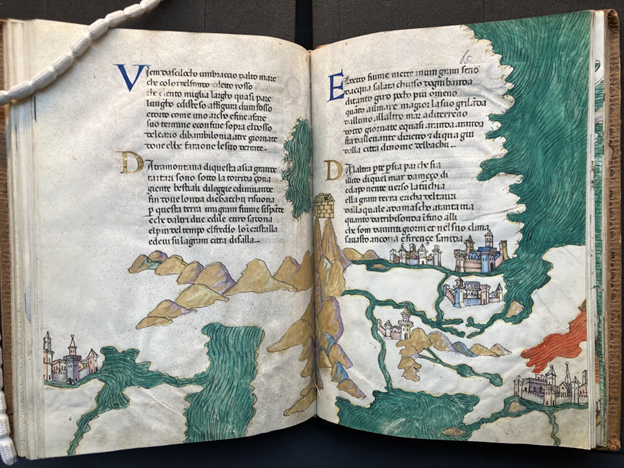Amanda Madden Receives NEH Funding to Create a Digital Edition of Goro Dati’s Sfera
Amanda Madden of the Roy Rosenzweig Center for History and New Media (RRCHNM), in collaboration with Carrie Beneš of New College of Florida, Laura Ingallinella of the University of Toronto, and independent scholar Laura Morreale, have been awarded a major grant as part of the National Endowment for the Humanities’ Scholarly Editions and Translations program. This grant will facilitate collaboration among a team of scholars to complete the La Sfera Project, an open-access multimedia edition of Goro Dati’s fifteenth-century poem La sfera (The Globe).
As a Florentine merchant, Dati led an exciting life: he was disappointed by deals that fell through, robbed by pirates, and cheated by unscrupulous partners. Toward the end of a fifty-year career in both commerce and politics, he wrote La sfera to introduce fellow merchant venturers to the cosmos, the natural world, and Mediterranean geography. Madden, who will lead the team at RRCHNM, argues for the importance of the project, highlighting how “La sfera overturns common misconceptions of what medieval people believed (that the world was flat, for example), and reveals how premodern Europeans understood the world around them before the so-called ‘Age of Exploration.’”
Map of the Middle East in book 3 of La Sfera, in a late-15th-century Italian manuscript (Oxford, Bodleian Library MS Canon. Ital. 74, ff. 64v-65r).
The La Sfera Project began in the summer of 2020 with the La Sfera Challenge, a digital event that brought together nearly a hundred medievalists from across the world for an online collaborative competition at a time when most other forms of professional interaction were locked down. During a pair of two-week competitions, teams of scholars raced each other to transcribe a total of eight digitized manuscript copies of La sfera. Morreale, who organized the 2020 events, explains that “public engagement was built into the La sfera enterprise from the start and will remain essential to it as NEH funding supports the project’s expansion. We are particularly interested in sharing newly accessible versions of the text, such as the one recently purchased by the Library of Congress in Washington, DC.”
The La Sfera Project will integrate a new critical edition of Dati’s treatise, an annotated English translation, IIIF manuscript images, a cartographic interface to plot geospatial data, along with materials to contextualize Dati’s work and a platform to facilitate public contributions to the site. According to Beneš, who will oversee the analysis and presentation of La sfera’s maps, “There are more than 160 handwritten manuscripts of La sfera, each one of which is unique; our digital edition will showcase the richness of Dati’s treatise by combining text, images, and maps in ways that a static print edition cannot.” Ingallinella, who will lead the work on the poem’s Italian edition, adds, “La sfera was read in the fifteenth century by dukes, merchants, and schoolchildren; now we hope to create a space that welcomes everyone interested in the premodern period into Dati’s world.” The project therefore offers a unique perspective on a pivotal transitional moment between the Middle Ages and the Renaissance.
ABOUT THE NATIONAL ENDOWMENT FOR THE HUMANITIES
Created in 1965 as an independent federal agency, the National Endowment for the Humanities supports research and learning in history, literature, philosophy, and other areas of the humanities by funding selected, peer-reviewed proposals from around the nation. Additional information about the National Endowment for the Humanities and its grant programs is available at: www.neh.gov.
The NEH’s Scholarly Editions and Translations program supports collaborative teams who are editing, annotating, and translating foundational humanities texts that are vital to scholarship but are currently inaccessible or only available in inadequate editions or translations.

